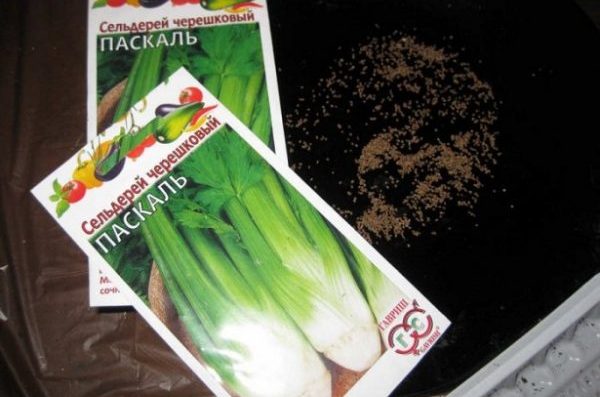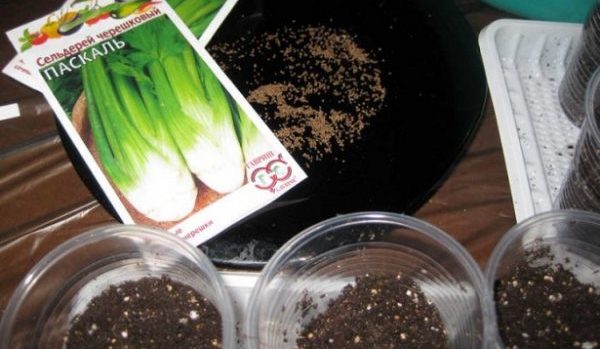How to plant celery seeds or seedlings
Content
Seed preparation
Before the very beginning of cultivation, the seeds are prepared for better germination after sowing. By themselves, they sprout for a long time due to the large amount of essential oils in themselves, which slow down germination. Without pretreating the seeds, growing seedlings can be a difficult process, because they may not germinate for almost a whole month, especially if they do not have enough moisture in the soil. To accelerate germination, the seeds need to be soaked and prepared for future sowing.
Methods for preparing seeds for growing root and stalk celery are described below. Method one - bubbling seeds in oxygen-saturated water, followed by soaking in a 1% weak solution of potassium permanganate for about 45 minutes at a temperature of 20-22C, after which water rinsing occurs under running water and further sowing. The second method is based on soaking the seeds with a weak solution of potassium permanganate for 45 minutes and rinsing with tap water. The next step is to soak the seeds for 18 hours in Epin's solution (4 drops per glass of water) at normal room temperature and then sowing. It is undesirable to change the sequence of actions, otherwise you may not achieve good results in germination.
Video "How to grow greens"
Demonstration video on how to grow greens.
How to plant seedlings
Due to the long ripening period of root crops in celery and the relatively short summer for this crop, it is advisable to grow it by seedling method no later than February. Before planting seeds, they are treated with one of the above examples. Prepare boxes or pots of soil for future growing of celery seedlings. A few days before planting, it is necessary to spill the soil with boiling water of a solution of potassium permanganate. Sowing grooves should be made no deeper than 1 cm, and then thoroughly moisten the soil.
Seeds should not be sown too densely, the ideal distance is 4-5 cm. It is not necessary to cover the bed with earth, so the seedlings will germinate better and the likelihood of their non-germination will decrease. Watering is required to be carried out regularly and only from a spray bottle. The grow box can be covered with plastic or glass to create a greenhouse effect.
When the first shoots appear, the temperature in the room should be lowered to + 16C, for not so rapid pulling out of seedlings. Densely planted seedlings should be thinned out. In winter, when the seedlings still do not receive enough light, the seedlings stretch out strongly, so that this does not happen, they need to illuminate an additional clock with a lamp at a height of 30-40 above the box. When the second leaves of our seedlings only appear, it should be dived into separate containers with soil.
Preparing the soil
The preparation of the bed for celery begins in the fall, because this culture adores fertile lands. Zucchini, cucumbers, potatoes are good predecessors for its cultivation. In autumn, for digging, you need to add 3-4 kg of organic fertilizers, potash fertilizers 20 g and phosphorus fertilizers 35 g per 1 sq. M. Celery loves trace elements such as calcium and magnesium, but it hates acidic soils, therefore, if necessary, liming of the earth (deoxidation) occurs. It is important to remember that different organics are introduced for different varieties. So, for example, manure is applied under leaf and petiole, and compost is applied to root ones.
How to plant celery correctly
In May, dived seedlings can be planted on open ground, which has been prepared since autumn. For disembarkation, you should choose sunny days, which will be throughout the week. The distance between the plants should be at least 30 cm, the seedlings should not be buried too deep, otherwise the root crop will be uneven. After planting the seedlings, cover the garden bed, and when June comes, the covering material can be removed. Caring for celery is almost the same as for many other garden crops.
It is imperative that regular watering is required, after which you need to plow through the soil or mulch it, pull out weeds in a timely manner. Fertilizers are applied twice a season, 2 and 5 weeks after planting celery on open ground. The fertilizing mixture consists of 5 g of nitrate, 10 g of superphosphate and potassium salt, diluted in 10 liters of water. Watering is carried out in the evening and in the morning, half a liter for each plant. Let us consider in more detail the care of each variety of this plant.
For salads, leafy celery is most commonly used. The most delicate leaves to eat are young leaves, which are harvested from mid-June. Caring for such a variety is almost no different from the above, but the plant prefers to be both in the sun and in partial shade. Leaves are harvested for the winter by freezing. For this delicate and juicy greens are cut off, washed under water and allowed to dry well.
Cut and put into a container for further freezing. Petiole celery is easy to care for and the standard method is enough for it.
In addition, this plant loves shade. Upon reaching about 35 cm in height, the lower leaves are cut off. The petioles are tied at the top, and the lower part is tightly packed in thick opaque paper. Towards the end of August, they will get white color, juiciness and tenderness. Caring for such a variety involves abundant watering with water at room temperature, otherwise the lower part of the plant will harden and be tough to eat. After 45 days have been planted, the leaves are pruned so that the petioles remain 2 cm tall and the central buds are not damaged.
During the season, you can get 2-3 harvests of greens and petioles. Root celery is well suited for preserves and first courses. In addition to the standard care for celery, this variety, like its fruits, also requires separate care. At the beginning of August, the top layer of the earth is removed from the fruit (root) and the upper roots are carefully cut off. Root harvesting begins in late July and ends around September before the onset of frost. When harvesting, you need to carefully dig them out, otherwise the root crops, damaged are not stored for a long time, but rot.
Video "Celery in the garden beds"
Informational video with case studies and recommendations.





